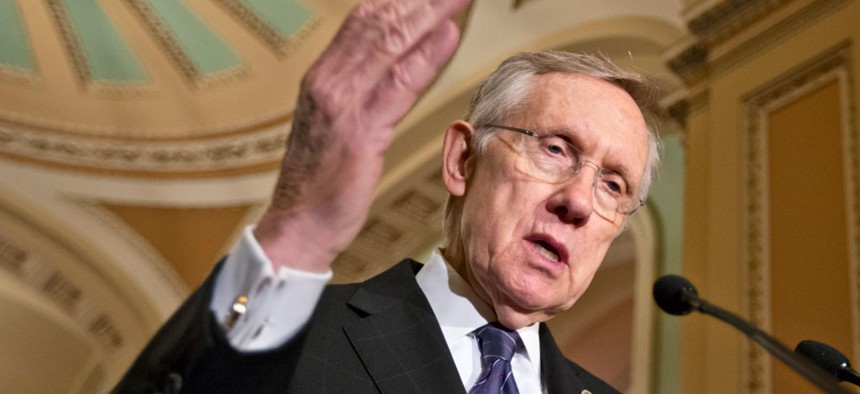
Senate Majority Leader Harry Reid, D-Nev. J. Scott Applewhite/AP
Senate Prepares for a Fight Over Sequestration
Democrats and Republicans divided over federal spending.
The Senate’s attempt to pass landmark immigration reform has yet to clear the floor, and already senators are drawing battle lines in what is likely to be the next big fight: spending levels.
Majority Leader Harry Reid, D-Nev., and Appropriations Committee Chairwoman Barbara Mikulski, D-Md., have said they hope to get spending bills to the floor in July, but tensions between Democrats and Republicans over the top-line spending levels in those bills are threatening to stall the process.
At issue is how to treat sequestration. Mikulski favors a level of $1.058 trillion, but Republicans support a $967 billion figure that they argue adheres to the Budget Control Act and takes sequestration into account. Democrats point out, though, that their figure adheres to the level agreed to in their budget.
“I’m hopeful that we can ultimately work together,” said Sen. Richard Shelby, R-Ala. “But you know, as I’ve said several times, we’re working off of different numbers right now. We’re going with the lower number, which is the law. If we could ever start working from the same number, I think Senator Mikulski and I could hopefully do a lot of bipartisan work.”
That seems unlikely to happen, though. Mikulski defended the higher figure at a recent hearing, saying, “My allocation assumes that we will work together, across the aisle, across the Dome, and across town with the White House, to find a solution to sequester before our final bills are enacted.” In other words, for Senate Democrats, the sequester is not here to stay.
The spending cuts, though, are a plum prize for Republicans, who have made cutting government spending a key part of their platform in recent years.
“I’ll be voting no until we start operating on the same number,” Shelby said. Some lawmakers on the committee suggested that rolling back the earmark ban could help loosen bills from the committee, but it’s uncertain if there’s broad support for that.
“I think part of the problem with appropriations this day and age is that since earmarks went away, you can’t get people to come together,” said Sen. Jon Tester, D-Mont., a member of the Appropriations Committee. “I think that’s real unfortunate. But that’s kind of been the glue that’s held the committee together. That glue is gone now.”
Appropriations bills have history of stalling as they leave committee en route to the floor. Regular appropriations bills have been enacted at the start of the fiscal year only four times since 1977, most recently for fiscal 1997. In the last Congress, 11 of the 12 bills cleared the committee, most with bipartisan support, but Congress still sought a continuing resolution to fund the government.
This year, the full committee has marked up the Agriculture and Military Construction-Veterans Affairs bills, both clearing the panel on a 23-6 bipartisan vote. Later this week, the committee is marking up the Energy and Water Development and Transportation-HUD bills. Mikulski said she expects to move legislation to the floor later this summer but she’s not yet sure exactly which bills.
“We’re optimistic that we’ll have something on the floor in July,” she said.
But even Democrats sounded skeptical about the prospects of moving most or all of the bills to conference.
“We’ve been here before,” said Sen. Tim Johnson, D-S.D., another Appropriations Committee member. “And this time we’ll try again. That’s all we can do.”
This article appears in the June 27, 2013, edition of National Journal Daily.







